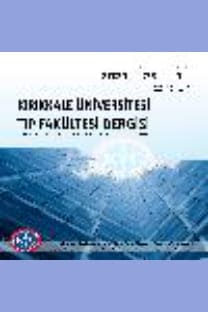Progesteron Serebral İskemi Yapılan Erkek Ratlarda İskemik Hasarı Artırır
Progesteron, inme, interlökin, HIF1, apopitozis
PROGESTERONE INCREASES THE ISCHEMIC DAMAGE IN MALE RATS WITH CEREBRAL ISCHEMIA REPERFUSION INJURY
Progesterone, stroke, interleukin, HIF1, apoptosis,
___
- 1. Elijovich L, Chong JY. Current and future use of intravenous thrombolysis for acute ischemic stroke. Curr Atherosclerol Rep. 2010;12(5):316-21.
- 2. Ishrat T, Sayeed I, Atif F, Stein DG. Effects of progesterone administration on infarct volume and functional deficits following permanent focal cerebral ischemia in rats. Brain Res. 2009;1257:94-101.
- 3. Espinosa-Garcia C, Aguilar-Hernandez A, Cervantes M, Moralí G. Effects of progesterone on neurite growth inhibitors in the hippocampus following global cerebral ischemia. Brain Res. 2014;1545:23-34.
- 4. Schumacher M, Robel P, Baulieu EE. Development and regeneration of the nervous system: a role for neurosteroids. Dev Neurosci. 1996;18(1-2):6-21.
- 5. Yousuf S, Atif F, Sayeed I, Tang H, Stein DG. Progesterone in transient ischemic stroke: a dose-response study. Psychopharmacology (Berl). 2014;231(17):3313-23.
- 6. Alkayed NJ, Harukuni I, Kimes AS, London ED, Traystman RJ, Hurn PD. Gender-linked brain injury in experimental stroke. Stroke. 1998;29(1):159-66.
- 7. Murphy SJ, Traystman RJ, Hurn PD, Duckles SP. Progesterone exacerbates striatal stroke injury in progesterone-deficient female animals. Stroke. 2000;31(5):1173-8.
- 8. Coomber B, Gibson CL. Sustained levels of progesterone prior to the onset of cerebral ischemia are not beneficial to female mice. Brain Res. 2010;1361:124-32.
- 9. Wong R, Renton C, Gibson CL, Murphy SJ, Kendall DA, Bath PM. Progesterone treatment for experimental stroke: an individual animal meta-analysis. J Cereb Blood Flow Metab. 2013;33(9):1362-72.
- 10. Calvert JW, Cahill J, Yamaguchi-Okada M, Zhang JH. Oxygen treatment after experimental hypoxia-ischemia in neonatal rats alters the expression of HIF-1alpha and its downstream target genes. J Appl Physiol. 2006;101(3):853-65.
- 11. Gredal H, Thomsen BB, Boza-Serrano A, Garosi L, Rusbridge C, Anthony D et al. Interleukin-6 is increased in plasma and cerebrospinal fluid of community-dwelling domestic dogs with acute ischaemic stroke. Neuroreport. 2017;28(3):134-140.
- 12. Li SJ, Liu W, Wang JL, Zhang Y, Zhao DJ, Wang TJ et al. The role of TNF-α, IL-6, IL-10, and GDNF in neuronal apoptosis in neonatal rat with hypoxic-ischemic encephalopathy. Eur Rev Med Pharmacol Sci. 2014;18(6):905-9.
- 13. Waje-Andreassen U, Kråkenes J, Ulvestad E, Thomassen L, Myhr KM, Aarseth J et al. IL-6: an early marker for outcome in acute ischemic stroke. Acta Neurol Scand. 2005;111(6):360-5.
- 14. Habib P, Dang J, Slowik A, Victor M, Beyer C. Hypoxia-induced gene expression of aquaporin-4, cyclooxygenase-2 and hypoxia-inducible factor 1α in rat cortical astroglia is inhibited by 17β-estradiol and progesterone. Neuroendocrinology. 2014;99(3-4):156-67.
- 15. Mohamed RA, Agha AM, Nassar NN. SCH58261 the selective adenosine A (2A) receptor blocker modulates ischemia reperfusion injury following bilateral carotid occlusion: role of inflammatory mediators. Neurochem Res. 2012;37(3):538-47.
- ISSN: 2148-9645
- Yayın Aralığı: Yılda 3 Sayı
- Başlangıç: 1999
- Yayıncı: KIRIKKALE ÜNİVERSİTESİ KÜTÜPHANE VE DOKÜMANTASYON BAŞKANLIĞI
SEKONDER GÖZ İÇİ LENS İMPLANTASYONU NEDENLERİ VE CERRAHİ SONUÇLARIMIZ
Reyhan OĞUREL, Nesrin GÖKÇINAR, Yaprak AKBULUT, Fatma ÖZKAL, Nurgül ÖRNEK, Zafer ONARAN
ROZASE HASTALARINDA KARDİYOVASKÜLER HASTALIK RİSK FAKTÖRLERİNİN ARAŞTIRILMASI
Tuba Betül KARADENİZ, Muhammed KARADENİ, Tijen ŞAHİN, Hatice Meral EKŞİOĞLU
UYANIK FİBEROPTİK ENTÜBASYON: BEKLENEN ZOR HAVA YOLU
Gülçin AYDIN, Ayşe Gizem SARAÇOĞLU, Ahmet Tuğrul ŞAHİN, Murat ALPARSLAN, Seydi GÜNDOĞAN, Yahya Fatih KOÇAK, Ela CÖMERT
BÖLGEMİZDEKİ AİLESEL AKDENİZ ATEŞİ HASTALARININ MEFV GEN MUTASYON TİPLERİNİN SIKLIĞI
Muharrem BAYRAK, Kenan ÇADIRCI, Oğuzhan YARAL
Koroner Arter Hastalığı ile Myokardiyal Köprüleşme Arasındaki İlişki
KALKANEAL EPİN HASTALARINDA VÜCUT KOMPOZİSYONU İLE AYAK AĞRISI ARASINDAKİ İLİŞKİNİN İNCELENMESİ
Özge VERGİLİ, Birhan OKTAŞ, Halime ARIKAN, Fatma Cansu AKTAŞ
DİSTAL HİPOSPADİAS ONARIMINDA TIPU TEKNİĞİ: 8 YILLIK DENEYİMİMİZ
Nesrin GÖKÇINAR, Yaprak AKBULUT, Tevfik OĞUREL, Salih KOÇ, Zafer ONARAN
